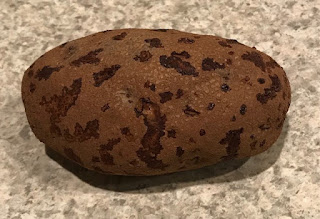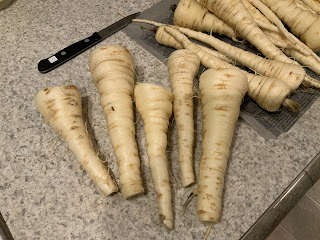 |
| Hawk in our woods |
But she wasn’t really lost—she was killed by a hawk. Right in front of my horrified eyes.
It was getting close to sunset—the girls were getting their last minutes of scratching in their yard, and in minutes, they would be going into the coop for the night. Ready to head outside and say hello to them, and top up the feeder, I gazed out the dining room window at the hen yard.
I saw something
strange: instead of the usual dark ground near their door, there was light stuff scattered
all around.
Then movement in the middle of the light stuff. An
animal.
The light stuff was obviously feathers.
“John!” I cried out. “Something’s got the hens!”
The attacker wasn’t that big. I started to cry as John ran to the back door and shoved his feet into his shoes. A small coyote? Then the animal moved its head. A red-tailed hawk.
I yanked on a sweatshirt as John raced outside. The hawk must’ve heard
a human coming, because it flew off. I caught up with John next to the fence.
He said, “She’s still moving.”
“Get some gloves on, honey." My breath caught as I entered the chicken yard.
There was a hen, lying on the ground—a big bloody gash at the top
of her breast. And completely still.
Crying, I called to him, “She’s not moving now—you must’ve just seen
her in her death throes.” As he went back to get a coat on, I looked around the
yard. So where were the other two girls?
I hoped against hope they had gotten into the coop in time. I went
inside and saw only one hen. She was milling around, not on the roost. “You’re okay, I said softly. Still, I was only
a little relieved.
I went back into the yard and looked around. Some twenty feet away from
the dead chicken, in the corner next to one of the woodsheds, I saw a patch of
blond and ran to it.
It was a hen. She’d wedged herself into the corner to tightly she was
halfway under the slats of the shed. She wasn’t moving. Yet there was no blood.
Or feathers on the ground.
But I was afraid she was dead too—of fright. I stroked her back. “Are
you alive, little girl?”
The hen moved ever so slightly. “Let me pull you out,” I told her, and
gently put my hands on either side of her and drew her toward me. She resisted,
and only burrowed further under the slats.
The fact she’d been strong enough to resist must prove she was
uninjured. I raced out of the pen and around to the shed. Boxes of
small logs and wood scraps were piled in the corner where the hen had taken
cover. I pulled the boxes away—and there she was, whole. She
blinked.
“You are alive,” I said in relief, and John approached. “I’ll bet she’ll want
the rooster to help her,” I suggested, and he was able to lift the unresisting
hen. We returned to the coop, and he gently placed her inside.
Two live hens. It was something to be grateful for. Together we returned to the dead hen.
I’d seen worse,
when a cougar had gotten our first flock and left pieces of the chickens all over the
pen. But still, I started crying again. “I’m sorry honey, this is my fault.”
“No it’s not,” said John. “It’s just nature. And remember, we just lost two hens on my watch."
It's true, John had been in charge in my absence. But this—the hen getting killed—felt like my fault: I’d let them out of
their cage just a half hour ago. When the hawk attacked I’d been only moments
from going to their pen. The girls had been only moments from going into their coop.
“We’ll bury her where I buried the other hen,” John said. The hen from our first flock years ago, that had also been killed by a hawk. He lifted
the dead hen. Her head dangled. “Her spine’s been completely broken.”
“I’ll dig the hole,” I said. Still crying, I grabbed a small shovel and followed him to a stump a little ways from my compost piles. He cleared away a bit of brush.
Angry with myself, I savagely sank the shovel into the ground.
Losing this hen felt so different from the other two last month. Then, there had
been no bodies. And I’d been away caregiving, my mind full of worries and the
family troubles I was facing. Now, actually seeing the hen killed hit me in a
whole new way.
Not that helping to bury her helped. I dug a small hole about a foot
deep, and John nestled the hen in it. He covered her up, filling the hole and
patting the earth as he finished. “You’re safe in hen heaven now,” he told her.
“Away in the Happy Hunting Ground,” I said, and trudged back to the
coop.
I went to say hello to the other two hens—they were still awake--and filled the
feeder. One of them actually came out to the feeder and nibbled a little. Then as they
climbed on the roost, I returned to the yard and tried to clean up the feathers, raking them into two
piles. But there were still so many more scattered around.
We had a big northeaster coming early the next morning, and I hoped it
would blow the feathers away. To help take away my memory off the killing.
I knew John’s heart was as heavy as mine. Before he went in, I said,
“Now that the hawk knows it’s found a sure food source, it’s going to keep
coming back here until it gets every last hen.” He nodded soberly.
We both knew the hen-caring policy we’d started a few weeks ago had
been wrong.
We’d always wanted to let the hens out of their wire-covered cage every
day, to scratch and nibble on weeds, get a little sunshine—or on a cloudy day, simply get some natural light.
But that would be in the past. Going forward, we couldn’t let the hens
out of their cage into their uncovered yard just because we were home, and
could see them through the window. Nor could we let the hens out while we were
outside, doing garden chores or firewood chopping.
The new policy: we absolutely can not let them out of their cage unless
we are right there in the yard with them. Hawks are such majestic creatures, but with this attack, I hated them.
It was a hard lesson.
And now our little flock is down to two.
 |
| Happier days, happier hens |





